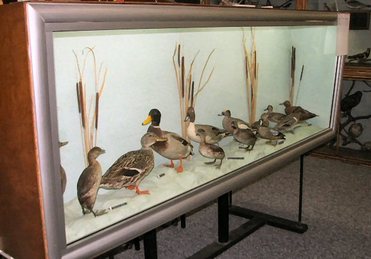Stempel Bird Museum311 Main Street
Macedonia, IA 51549 Open by Appointment: Ruby (712) 486-2568 Donna (712) 486-2580 City Hall (712) 486-2323 Dr. Guido Louis Stempel, M.D. (1836 – 1917) was a self-made authority in the areas of ornithology and entomology. Then and now, his bird and butterfly collections were considered to be the best in the state of Iowa. After the disintegration of his collection of over 3,000 butterflies due to inattention over the years, in 1967 the Stempel family generously decided to donate his collection of 312 birds to the care of Pottawattamie County Conservation Board for display to the public. In this way, the mission of Dr. Stempel was realized-that future generations would still be able to observe species that were rapidly becoming endangered and may soon be extinct. Born the youngest of eleven children in Drachhausen, Germany in 1836, Stempel spent the first eleven years of his life happily roaming the countryside among the flora and fauna that would always be a passion in his life. In 1848, with Germany’s political condition deteriorating, Stempel’s father decided to take his family to the new world of the United States, where they may live without being subject to a potentate. After sailing for seven weeks aboard a three masted sailing ship, the family reached land in Baltimore, Maryland. After resting for a few days, they continued their journey by riverboat across the Alleghenies to Brownsville on the Monongahela River. Then the Ohio and Mississippi Rivers eventually delivered them to Keokuk, Iowa, where they were forced to land due to ice masses obstructing the river. A thriving boomtown, Keokuk had no houses to rent for the large family, so they continued overland forty miles further to Fort Madison, Iowa. Here they found two rooms to rent for the winter, planning to continue their journey in the spring. It did not take long, however, for the family to make many good friends and decide to settle in the area. Unfamiliar with the land on the Mississippi bottoms between Fort Madison and Burlington. What looked so good in the winter was soon under one to six feet of water in the spring. Determined to make a return on the land, that summer young Stempel and two of his brothers moved to a one-room log cabin and began raising cattle. Despite the fact that the three brothers all contracted malaria after less than a year on the land, the family soon began to build a larger home and moved together to the farm. That summer of 1849 was a sad one, bringing the death of Stempel’s father and a break-up of the family. An orphan at the age of 13, Guido Stempel now had to support himself. After working in a bakery and then making cigars, Stempel got a job working with one of his brothers in a harness shop in 1852. In the winter of 1853, the boys went ice skating on Sunday and were caught by their very religious-minded employer. Faced with fire and brimstone sermons, and threats of Sunday school, the brothers decided to run away. After traveling along the Mississippi River for some time, the brothers finally found work in another harness shop in Keithsburg, Illinois, where they remained until 1855. When another brother opened his own shop in Fort Madison, the boys returned, only to have the business fail in a year. After trying the fur trade business and gold fields in Colorado, the brothers returned once more to Fort Madison. The turning point in Guido Stempel’s life came in 1857, at the age of twenty. A brother, then deputy county treasurer, made Stempel manager of some land he had bought near Fort Madison. While converting the land to vineyards and orchard, Guido could indulge in his passion with nature. During this time, Stempel met and married Johanna Koehler, had three children, Hugo, Bianca and Maximillian, and established his own home in the bluffs of Fort Madison. He also met a fellow bird and butterfly enthusiast, Dr. August Hoffmeister, who was to have a great influence in both his vocation and avocation. After studying medicine at Parks College, in 1866, Dr. Stempel was appointed hospital steward for the Iowa penitentiary at Fort Madison, where he studied medicine under Dr. Hoffmeister. After completing his studies in 1872, Dr. Stempel practiced medicine in Cedar Bluffs, Iowa and Chicago, Illinois before moving to Macedonia, Iowa where he remained to practice medicine and ran a drug store. Dr. Guido Stempel did much of his bird and insect observing and collecting in Fort Madison and then Macedonia. After twenty-two years of collecting in Iowa as well as other states both near and far, his collection became known as one of the finest in the state. Dr. Stempel was widely held as an authority in these areas. The Stempel Bird Collection was donated to the Pottawattamie County Conservation Board by the Stempel family in 1967. After some renovation, the collection was put on display at the Pottawattamie County Courthouse in Council Bluffs, Iowa. This collection contains 229 birds from many different habitats. 83 additional duplicate birds were on loan to Iowa Western Community College for display and study. In 2001, the collection was returned to the Stempel family heirs who placed them on loan in the old Macedonia City Hall. Although some of the mounts are over 100 years old, it is testimony to Dr. Stempel’s medical skills and workmanship that so many of the birds are still of display quality. In his legacy, Dr. Stempel not only leaves us with examples of birds that may be rare or even extinct in future years, he also leaves us with the incentive to preserve that native habitats of the creatures in order that future generations may see more than just birds behind glass. |




